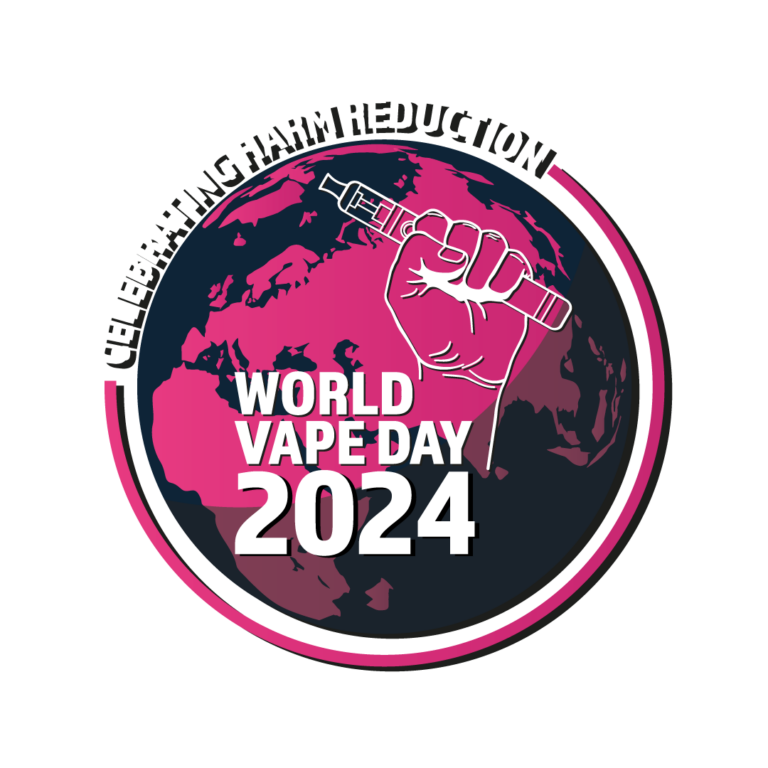
It’s on May 30th, 2024
On Thursday, May 30, the vaping community worldwide will be celebrating harm reduction efforts around the globe. The choice of date is not coincidental and falls just one day before the World No Tobacco Day proclaimed by the WHO: precisely to showcase that vaping and other harm reduction tools are one of the most efficient ways to help smokers quit.
This year, WVD will focus on the theme of the “Misperception Epidemic” We’re here to expose how widespread misinformation is blocking smokers from switching to safer alternatives. By tackling misconceptions head-on, we want to empower individuals with evidence-based knowledge and spark meaningful conversations about how vaping can fast-track us to a smoke-free world.
Rzeczywistość: Vaping jest o 95% mniej szkodliwy niż palenie.
Vaping is often mistakenly believed to be as harmful as smoking. However, while vaping is not completely risk-free, it poses significantly lower risks than smoking – 95% lower according to Public Health England.
Combustion cigarettes release thousands of chemicals, including up to 70 carcinogens and other toxins like tar and carbon monoxide. Due to the lack of combustion and the differences in ingredients, most of these harmful chemicals are not present in the vapour of electronic cigarettes, making nicotine consumption much less harmful and lowering the risks of smoking-induced illnesses like cancer, lung disease, heart disease, and stroke.
Reality: Vaping has already helped millions of smokers to quit.
Evidence has shown that vaping is one of the most effective ways to quit smoking, and more effective than traditional nicotine replacement therapies like nicotine patches or gums. They can even help reduce nicotine dependence thanks to the possibility to adjust nicotine concentration levels. Smokers find it an attractive alternative because of the similar action of putting a cigarette in the mouth and the similar sensation of feeling the smoke in the throat.
Reality: Nicotine is not the problem.
Smoking-related illnesses and deaths are caused by the harmful ingredients in traditional cigarettes and the toxins liberated during combustion, not by nicotine.
Nicotine is an addictive substance, but it is relatively harmless to health and does not increase the risks of severe illness or mortality. As we know, nicotine is not a problem in conventional nicotine replacement therapies. Therefore it cannot be a bigger problem in vaping.
Reality: Vaping is not related to EVALI or popcorn lung.
EVALI is linked to illicit THC vape products containing vitamin E acetate, while popcorn lung is caused by diacetyl. Both substances are banned as e-liquid ingredients and cannot be found in legal vaping products.
Reality: Vape aerosol is different from cigarettes smoke and is harmless to those around you.
E-cigarette vapour and cigarette smoke are considerably different. Smoke results from cigarette combustion, which releases thousands of harmful chemicals, some of them carcinogenic, while vape aerosol results from the heating of e-liquids, which contain common food ingredients that are safe to ingest.
Research shows that those near a vaper inhale 100 times less nicotine than a passive smoker, ruling out the existence of the passive vaper.
Rzeczywistość: Vaping jest bramą do wyjścia z palenia.
W wielu krajach liczba osób palących codziennie jest na najniższym odnotowanym poziomie. Vapingowi przypisuje się pomoc ludziom w rzuceniu palenia, a badania pokazują, że jest on dwukrotnie skuteczniejszy niż nikotynowa terapia zastępcza. Twierdzenie o bramce nie jest poparte dowodami, ponieważ tylko 1,5% osób niepalących [w Wielkiej Brytanii] obecnie spada. Bardzo szanowana organizacja pozarządowa Cochrane zajmująca się zdrowiem i różne agencje zdrowia zalecają wapowanie jako sposób na rzucenie palenia ze względu na jego skuteczność.
Rzeczywistość: Ponad dwie trzecie dorosłych vaperów używa smaków innych niż tytoń.
Krytycy, którzy chcą zakazać wapowania smaków, twierdzą, że są używane tylko przez nieletnich i służą jako brama do palenia. Jednak aromaty są przeznaczone przede wszystkim dla dorosłych, aby rzucili palenie poprzez maskowanie smaku tytoniu. W rzeczywistości ponad dwie trzecie vaperów regularnie używa smaków innych niż tytoniowe. Aromaty nie tylko pomagają rzucić palenie, ale także zmniejszają prawdopodobieństwo nawrotu nałogu. Yale School of Public Health donosi, że smakowe urządzenia do wapowania zwiększają szanse na rzucenie palenia przez dorosłych o 230%. Zakazanie smaków może spowodować, że połowa vaperów wróci do palenia lub czarnego rynku.
Rzeczywistość: Nie ma dowodów na to, że młodzi ludzie mają wpływ na palenie. Większość z nich próbuje wapowania po tym, jak już zaczęła palić.
Ograniczenie wapowania w oparciu o twierdzenie o epidemii wśród młodzieży nie jest poparte dowodami, aw większości krajów wapowanie osób nieletnich jest już nielegalne. Badania pokazują, że palenie wśród młodzieży spadło w Stanach Zjednoczonych, Niemczech i Wielkiej Brytanii, odkąd zaczęło rosnąć użycie e-papierosów. Czynniki środowiskowe, takie jak nawyki palenia rodziców i predyspozycje genetyczne, częściej prowadzą dzieci do wapowania lub palenia. Dowody sugerują, że waporyzacja może odciągnąć młodzież z grupy wysokiego ryzyka od palenia, a większość nastolatków próbuje waporyzować już po rozpoczęciu palenia. Przegląd piętnastu badań przeprowadzony w 2019 roku nie znalazł dowodów na prawdziwy efekt bramy u młodzieży.
Rzeczywistość: Wyższe podatki od vapingu mają negatywny wpływ na zdrowie publiczne.
Podwyżki podatków od produktów do wapowania skłaniają vaperów do przejścia na papierosy, zwłaszcza wśród młodych dorosłych. To z kolei szkodzi zdrowiu publicznemu. Zaleca się opodatkowanie oparte na ryzyku, z niższymi podatkami od mniej szkodliwych produktów, aby zachęcić palaczy do zmiany nałogu. Ograniczanie dostępu do produktów do wapowania poprzez wysokie ceny ma niezamierzone konsekwencje, ponieważ użytkownicy zwracają się ku czarnemu rynkowi lub paleniu. Nieuregulowane produkty z czarnego rynku są bardziej szkodliwe, ponieważ nie spełniają przepisów bezpieczeństwa, stwarzając zagrożenie dla użytkowników i zdrowia publicznego.
Rzeczywistość: Ponad 100 organizacji zgadza się, że waporyzacja jest prawdopodobnie mniej szkodliwa niż palenie w oparciu o zasady naukowe, pomimo nieznanych długoterminowych zagrożeń.



Help us spread the word!
World Vape Day is right around the corner! It’s a joyful day when we celebrate the lives saved by this innovative technology. To help you invite your friends and your community, we prepared promo materials – and they are free to use and publish for everyone!
Our goal is to raise awareness about the Swedish success in tobacco harm reduction and encourage Swedes to celebrate their achievement. We will spread Sweden’s success story on the EU level, among EU member states and an international audience through political outreach, but also in the media and the vaping community. We will run digital and grassroots events, and help vapers raise their voice.
Let’s take action and beat smoking rates like the Swedes. By embracing harm reduction, we can achieve smoke-free societies and improve public health for all.
© 2024 – World Vapers’ Alliance. All rights reserved.